WHAT IS CONTENT MARKETING AND WHY IT IS IMPORTANT FOR YOUR Brand – Business

When you hear the word my Brand; what usually comes to mind on that note? or rather when you hear the word our brand!
Brother and sister across the world I must tell you that to build the smallest competing brand across the world is not easy but definitely a strategy can win for you.
The question now is what strategy are you currently using to build a compelling brand?
Note at some point of this write up we would be considering Content Marketing as CM
Let us move now as you might consider into content marketing.
Content marketing is a strategic marketing approach focused on creating and distributing valuable, relevant, and consistent content to attract and retain a clearly defined audience — and, ultimately, to drive profitable customer action. Instead of pitching your products or services, you are providing truly relevant and useful content to your prospects and customers to help them solve their issues.
Now, are we solving an issue for you? then, kindly write digital@xinicomms.com to appreciate this piece we have brought forward to you so that you can learn daily.
Then, after knowing what cm is all about in definition the next question that pops is How To Develop Viable Contents?
How To Develop Content Marketing Strategy
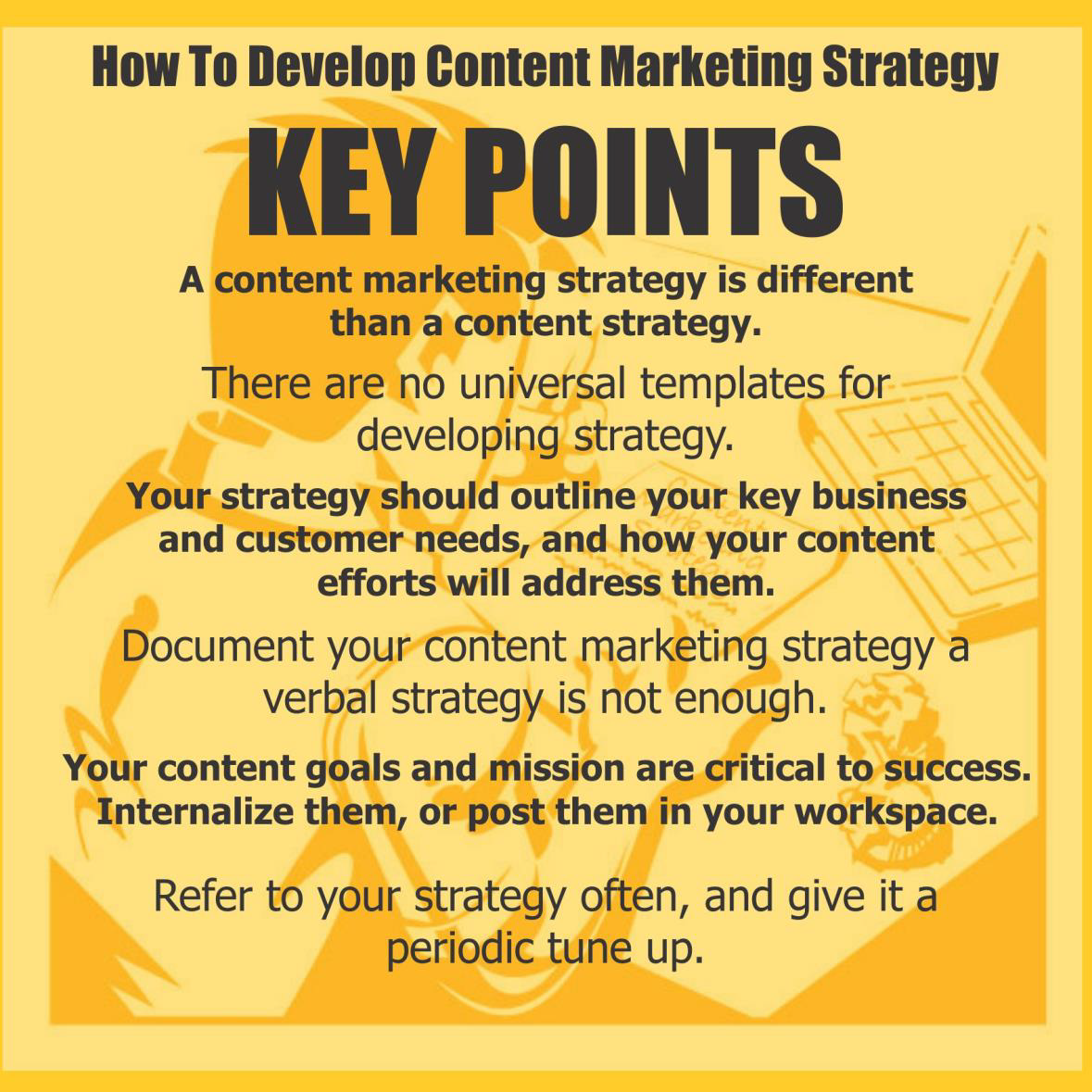
On average the gist is that people like story as much as they want something short because of their business schedules.
In fact, having a documented strategy is critical, as it’s one core element that separates effective content marketers from their less effective peers. As we’ve seen in the responses in our annual research, those with a documented content marketing strategy:
• Are far more likely to consider themselves effective at content marketing
• Feel significantly less challenged with every aspect.
• Generally consider themselves more effective in their use of all content marketing tactics and social media channels
• Are able to justify spending a higher percentage of their marketing budget on content marketing Here are a few common questions to help you start creating a content marketing strategy from scratch or improving the one you may already have in place.
Is there a template I can follow?:
There is no one “template” for creating a content marketing strategy, as every company must approach this technique from its own unique perspective, based on its specific marketing needs and requirements. However, there are a few common elements that every content marketing strategy should have in common (see below).
Does my strategy need to be documented?:
It’s not critical that you document your strategy, but from my experience, something almost magical happens when you put pen to paper and document the specifics. Connections can more easily be drawn, and it helps to get everyone on the same page.
What types of information should my content marketing strategy cover?:
We suggest including the following components as you develop your strategy:
• A business plan for innovation: This is optional, but if your organization is not used to incorporating new processes like content marketing into its operations, you may need to start by convincing your stakeholders to allow you to innovate. Why? Quite simply, this gives you permission to do what it takes to succeed, yet covers your bases in case you fail. By definition, innovation means doing something that hasn’t been done before so there’s no way to guarantee return on investment (ROI) before you have a chance to experiment. By including an innovation plan in your content marketing strategy, you are making sure everyone’s expectations are aligned.
• A business plan for content marketing: Once your organization has agreed to experiment, the next step is building the business plan for the content marketing program itself. It’s important to note: The business case is not meant to outline guaranteed ROI. Trying to pin ROI on Cmarketing right from the outset is a bit like asking, “What’s the ROI on your telephone system?” you won’t know until you start to get a sense of how much (and how well) it will be used.
• Personal development and content mapping: This part of the strategy helps your content team recognize your buyers as people with informational needs, and helps them create content to address their questions at each stage of the buying cycle.
• Your brand story: people like stories-As part of your strategy, you will need to determine what your “pillars of content” in essence, the stories you want to tell will be. This will be more of a framework than a fully realized to-do list or template, as its purpose is to help you to develop the best way to tell your story (or, perhaps, to help you discover what’s missing from your company’s existing story).
• A channel plan: This component focuses on how you plan to “place” the content you create i.e., which channels will be most beneficial for your content distribution efforts?
How do I communicate my strategy internally?:
This very much depends on your organization. In some cases, it makes sense to have specific executive summaries targeted at different stakeholders. In other cases, you may want to develop a small-scale “pilot” program that allows you to test a few options, prove success, and then build onto your cm program from there.
Regardless of your approach, you’ll find it helpful to apply the principles of content marketing to your efforts to market your plan, as well. In other words, make it about your audience members’ needs: What will they care about most, and what information will they need to make decisions and allow your content marketing efforts to move forward?
Does a content marketing strategy differ from a content strategy?: Yes! While people often use these terms interchangeably (understandable, as the lines are somewhat blurry), Robert Rose makes this useful distinction:
• Cmarketing strategy: Content marketers draw and develop the larger story that our organization wants to tell. They focus on ways to engage an audience, using content to drive profitable behaviors.
• Content strategy: On the other hand, content strategy delves deeper into (in Kristina Halvorson’s words) the “creation, publication, and governance of useful, usable content.
WAYS TO USED CONTENT MARTKETING
Increasing your brand awareness doesn’t happen overnight, but it’s an important goal to keep in mind for any business. One of the best ways to achieve this is with cM.
Below are the ways to use content marketing:
Content marketing is used by leading brands
Our annual research shows the vast majority of marketers are using content marketing. In fact, it is used by many prominent organizations in the world, including P&G, Microsoft, Cisco Systems, and John Deere. It’s also developed and executed by small businesses and one-person shops around the globe. Why? Because it works.
How Microsoft is Shifting Focus Towards Content Marketing
When you think of Microsoft, words like innovation, technology, and cutting-edge probably come to mind. To keep that brand perception alive, the giant tech corporation is slowly adopting a culture of content to fuel its $340 billion business.
As a large enterprise with over 118,000 employees, aligning content goals across the organization can be more challenging than you might think.
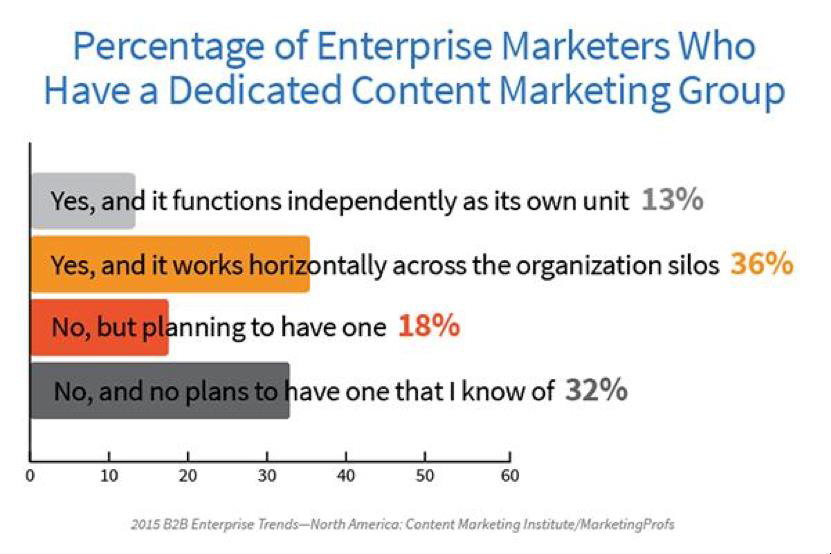
Content marketing is good for your bottom line and your customers
Specifically, there are three key reasons and benefits for enterprises that use content marketing:
• Increased sales
• Cost savings
• Better customers who have more loyalty
Content is the present and future of marketing
Go back and read the content marketing definition one more time, but this time remove the relevant and valuable. That’s the difference between content marketing and the other informational garbage you get from companies trying to sell you “stuff.” Companies send us information all the time – it’s just that most of the time it’s not very relevant or valuable (can you say spam?). That’s what makes content marketing so intriguing in today’s environment of thousands of marketing messages per person per day.
Marketing is impossible without great content
Regardless of what type of marketing tactics you use, content marketing should be part of your process, not something separate. Quality content is part of all forms of marketing:
• Social media marketing: Content marketing strategy comes before your social media strategy.
• SEO: Search engines reward businesses that publish quality, consistent content.
• PR: Successful PR strategies address issues readers care about, not their business.
• PPC: For PPC to work, you need great content behind it.
• Inbound marketing: Content is key to driving inbound traffic and leads.
• Content strategy: Content strategy is part of most content marketing strategies.
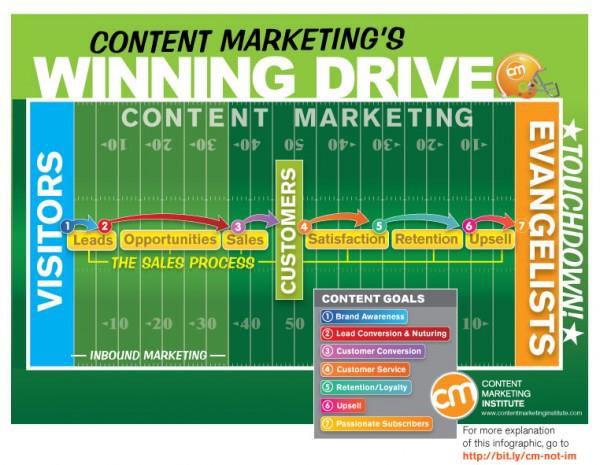
Content marketing Strategy
Tons of different Cmarketing strategies exist today.
In the beginning of the Cmarketing world, that wasn’t the case. At one time, marketers had few options. They essentially only had bandit signs, magazines, and newspaper ads.
Even in those days, however, they had a variety of different custom choices.
They could play with the words in their advertisements, the picture they showed, the placement of it, and the CTA.
In other words, although there were few cm methods, the options were still remarkably vast.
Today, more content marketing mediums and methods exist than ever before in the history of the world. That means that the number of strategies is even greater.
One online publication suggests using the“3D content” model, for instance. Basically, it’s three individual steps.
1. Map the content to the pain point.
2. Then use the right type of content for that problem.
3. Finally, map the content to the buying cycle of the people who have that problem.
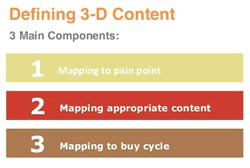
This strategy is a way to move the focus away from the marketer and to the person that the marketer is trying to reach.
That, after all, is an incredibly important step to take in your own content marketing strategy.
If your content doesn’t cater to the right people with the right problem that your product solves, then your content marketing efforts are all for not.
Of course, you’ll probably want to adapt this to fit your own audience and marketing theories.
Whatever the case, though, you should always start with your audience. You must create content for that audience. Then, and only then, will the right people pay attention to you.
Now, the WHY? of everything in life is important.
Why Content Marketing? Perhaps more important than understand what content marketing is, is understanding why content marketing is important to your business. First we need to understand the four steps of the buying cycle:
1. Awareness. Prior to awareness a customer may have a need, but they are not aware there is a solution.
2. Research. Once a customer is aware there is a solution, they will perform research to educate themselves. For example, a car buyer will try to find out what different types of cars exist, and which one will fit their needs.
3. Consideration. At this point the customer starts comparing different products from different vendors to make sure they’re getting a high quality product at a fair price.
4. Buy. Finally, the customer makes their decision and moves forward with the transaction.
Traditional advertising and marketing is great when it comes to the second two steps. Content marketing taps into the first two stages of the buying process by raising awareness of solutions and educating consumers about a product they may have never considered before.
At my own company we’ve used content marketing to grow more than 1,000% over the past year. Potential clients find our content, find value in it, and by the time they contact us they’re already convinced they want to work with us. We don’t have to engage in any high pressure sales tactics, it’s merely a matter of working out details, signing an agreement, and getting started. The trust that usually needs to be built up during an extensive sales cycle has already been created before we know the potential client exists.
The return on investment for content marketing can be phenomenal if executed correctly. We haven’t spent a dime on our own content marketing, or even that much time. 95% of the success we’ve experienced with content marketing can be traced to a handful of articles I’ve written, adding up to perhaps 20 hours of work.
Cmarketing also provides additional benefits in that it supports other digital marketing channels. It provides additional content for social media marketing and contributes to SEO efforts by generating natural inbound links and building up good content on your website that gets found in search engines. In fact, for many companies the bulk of their SEO efforts should be focused on content marketing.
How Do I Get Started?
There are many firms that offer content marketing services, often paired with SEO or PR. If you’re simply too busy to do it yourself and aren’t ready to manage it in-house, then hiring a firm may be your best option. But if you want to jump in and do your own the easiest way is to start blogging. It will likely be hard at first, but the more you do it, the better you’ll get at it. Following tips from websites like copy blogger you’ll quickly learn how to craft content for your website or blog that will engage readers and turn them into customers or clients. But while technically good writing and the right headlines can help, it’s not the key to creating great content that is the best form of content marketing.
Great Content
When we say great content, what do we mean? Dope!
If you’ve ever slogged your way through reading a piece of marketing and only finished reading because you had to, then you’ve experienced bad content marketing. When I speak to companies about content marketing I tell them that content is good if they genuinely want to read it. Content is great if they’re willing to pay to read it. If you want to see great examples of content, just look at what you’ve paid to read, watch, or listen to lately. If you watched The Lego Movie this year, you saw one of the greatest examples of content marketing to date. Oh, you thought they made that movie in order to sell movie tickets? Think again. That was a 100 minute toy commercial, and rather than using a DVR to skip it you paid good money to watch it. Is it any coincidence that Lego recently leapfrogged Mattel, the creators of Barbie, to become the largest toy company in the world? You may not have the budget to make a feature film to promote your company, but you can still give potential customers valuable information.
The #1 Secret of CMarketing
Add value. That’s the secret. It’s not really a secret at all. We’ve already talked about it throughout this piece. Although when you look at some of the marketing companies engage in you wonder if they’re purposely avoiding the obvious. We skip advertising when it provides little to no value. If you want to learn about advertising that doesn’t get skipped, find a skateboarder and ask him if you can watch him look through a skateboard magazine. You’ll see that he spends as much time looking at the ads as he does looking at the articles and photos. Or check out The Berrics website. Much of the content is advertisements, but skaters don’t skip these videos, they watch them just like they watch the other videos, because they’re getting the value they want–good skating. As a skater I’d like to say skateboard companies pioneered content marketing decades ago, but I know they were only doing what came naturally, and selling more product was secondary to the fun of creating videos and magazines. If you want to hire someone onto your marketing team who understands cm intuitively, hiring a skateboarder might not be a bad step.
If you’re not sure how you can add value through content marketing, ask your existing customers what kind of content you can produce that would be helpful to them now, or would have been helpful to them when they were looking for your product or service. They’ll tell you.
Most companies are not doing real content marketing…yet. That’s why you’ll have an advantage if you jump in. Let me know how it goes because at the heart of Lagos Nigeria we are always trying to ensure that clients get the real value of what they bring into the table.
Create a Content Marketing Strategy
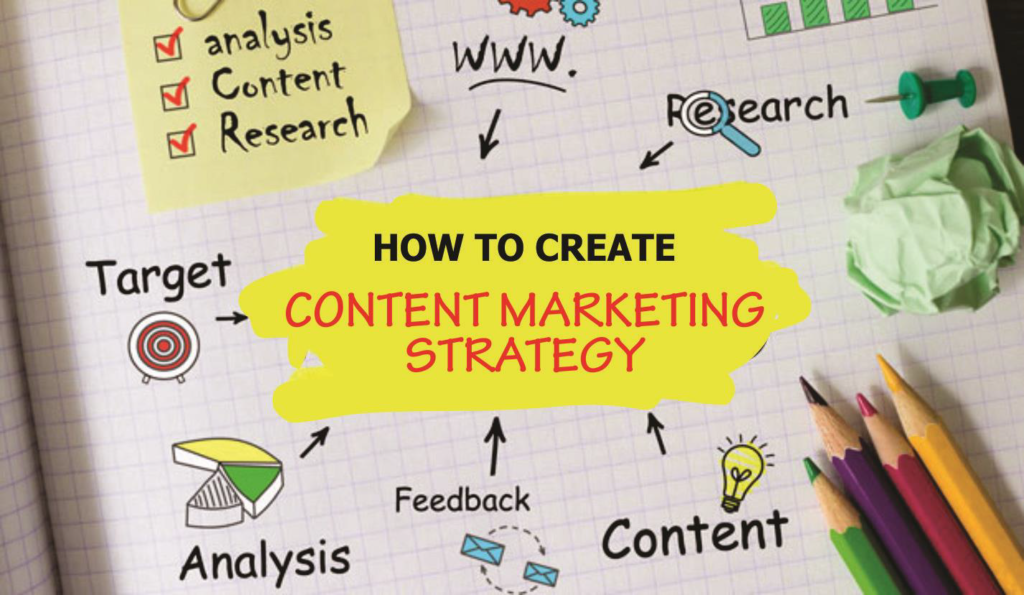
Wouldn’t it be great to start your content marketing program knowing it will work as intended? How satisfying would it be to be confident it incorporates the insights, ideas, and focus to create stories that captivate your audience members and turn them into loyal customers?
While we can’t offer a magic formula that guarantees success, we can identify the key practice the most-accomplished content marketers adopt: They document a marketing strategy.
Why? The obvious answer is that strategy creation seems difficult. It takes thought, research, and time to plot all the details. You can’t just borrow a strategy and put it into play for your business.
This process will help you create a content marketing strategy to guide your efforts, providing significant advantages at every stage of your program. A strategy boils down to decisions in three distinct areas:
Why – marketing and business purpose
Who – audience needs
How – unique brand story
1. Identify your business why Goals and intentions
Define the business challenges and outcomes to address and achieve with content marketing. In other words, figure out why you’re creating content and how you intend for it to help your business.
Though your content marketing program can help address multiple marketing challenges, the discipline works best when focused on a single, top-priority goal. An easy trick to help accomplish this is to identify points in your funnel where the team struggles the most to reach the goals.


